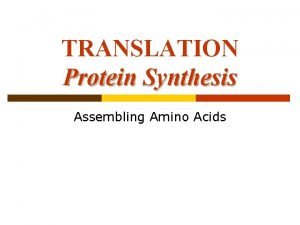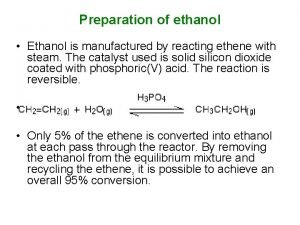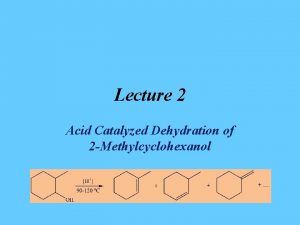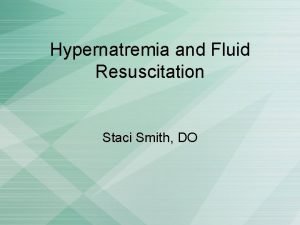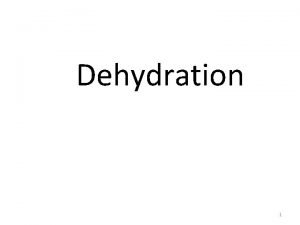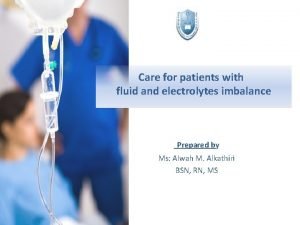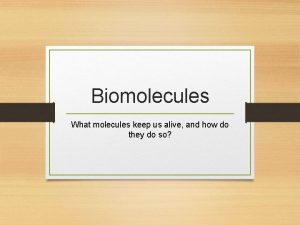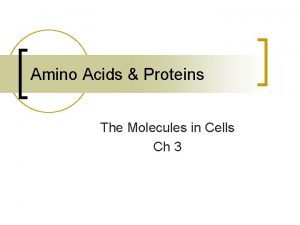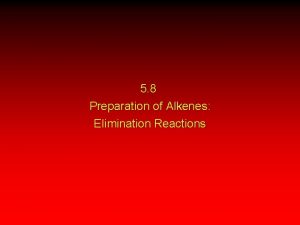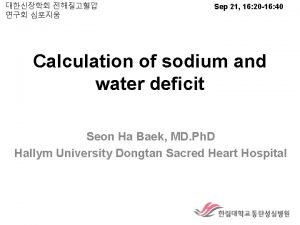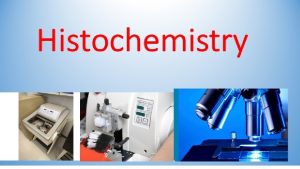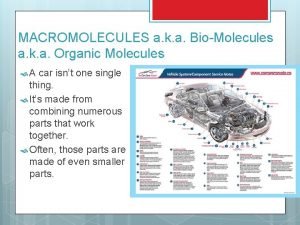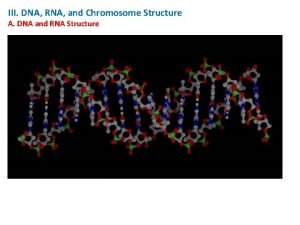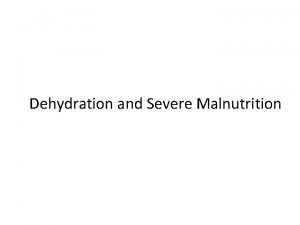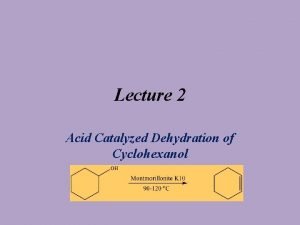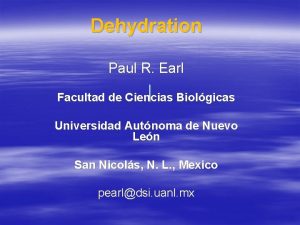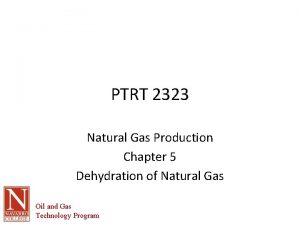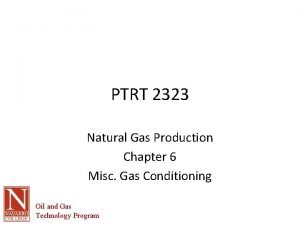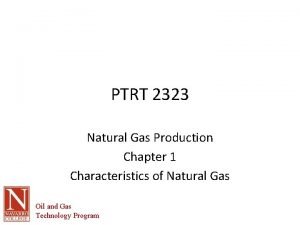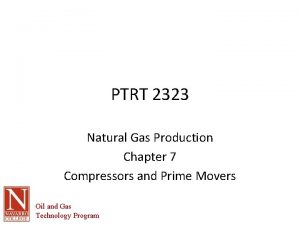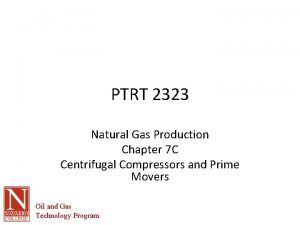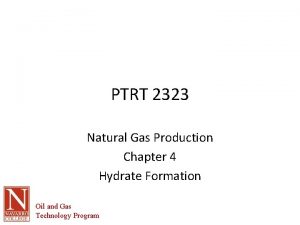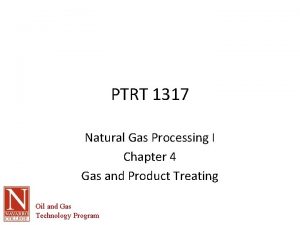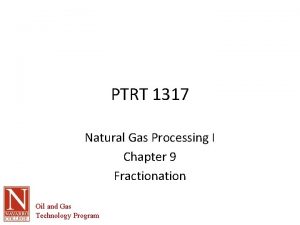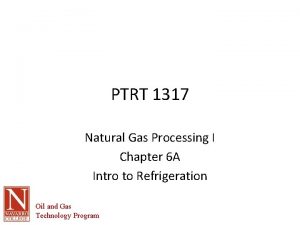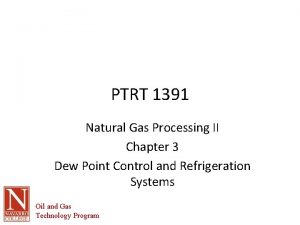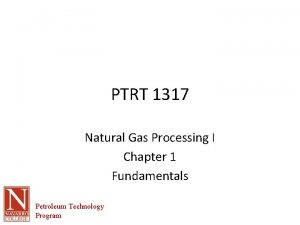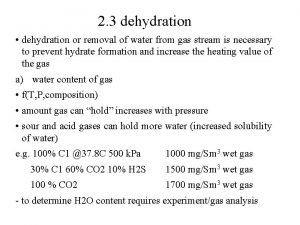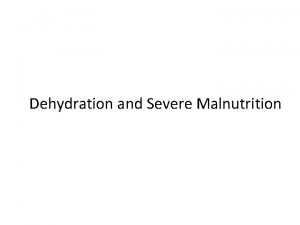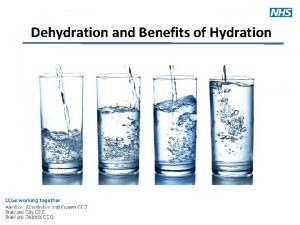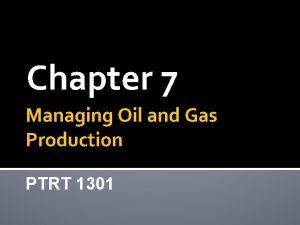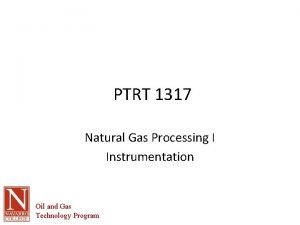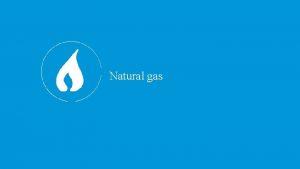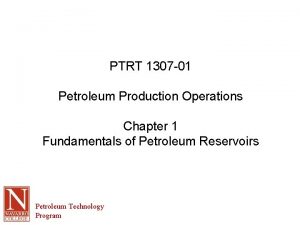PTRT 2323 Natural Gas Production Chapter 5 Dehydration




























- Slides: 28

PTRT 2323 Natural Gas Production Chapter 5 Dehydration of Natural Gas Oil and Gas Technology Program

Dehydration • Removal of water vapor – Adsorption • Water is trapped on the surface of pores in a solid (think of connate water) – Absorption • Water is absorbed by a liquid with a higher affinity for water than the natural gas • Removal takes place inside an absorber (contactor or tower) • Key factor is controlling dew point – dew point depression. – Dew point is the temperature at any given pressure for which the gas is fully saturated with water vapor – Dew point must be decreased below the hydrate formation temperature for a given set of conditions • Two primary systems in use today use one of these two techniques – Liquid desiccant dehydration – Solid desiccant dehydration Oil and Gas Technology Program

Liquid Desiccant Dry Desiccant Oil and Gas Technology Program

Dew Point Depression • Hydrates do not form unless the gas is saturated AND contains additional free water • Warm gas holds more water than cold gas and thus takes more water vapor to reach saturation • Heating cold gas allows it to absorb the free water and if temp is high enough will become undersaturated • Undersaturated gas cannot form hydrates Oil and Gas Technology Program

Dew Point - example • Natural gas at 500 psia and 60 ⁰F • At saturation this gas will hold 30 lbs water vapor per MMcf • The dew point is 60 ⁰F • Suppose this gas is to be transported to a location where the temp is only 20 ⁰F • The dew point at 20 ⁰F is only 7 lb/MMcf • Thus there would now be 23 lbs of free water in the gas. • The dew point must be depressed below 20 ⁰F • Real world is a bit more complex Oil and Gas Technology Program

$ $$ TEG • Superior desiccant • Easier to regenerate • Higher decomposition temperature $$$$ Oil and Gas Technology Program

Dry Gas Glycol Wet Gas Oil and Gas Technology Program

Glycol must be reused Too expensive to throw away > $4. 00 / gal Oil and Gas Technology Program

Definitions • Wet gas – Gas containing water vapor prior to desiccation • Dry gas – gas leaving the absorber • Desiccant – dehydrating (or absorbing) medium (in most cases TEG) • Lean glycol – 95 -99% TEG by weight • Rich glycol - <95% TEG by weight (remainder is water plus impurities) Oil and Gas Technology Program

Flow diagram of liquid desiccant system Oil and Gas Technology Program

Absorber Tower • Wet gas enters at bottom • Intimate contact with gas via bubble caps • Water is absorbed by the TEG • Mist extractor at top • Gas processing is now complete • Remainder of system is for reprocessing the glycol Oil and Gas Technology Program

One Tray from an Absorber Tower Oil and Gas Technology Program

Bubble Caps Oil and Gas Technology Program

Mist Extractor • Surface area on which glycol mist can condense • Reduce carryover and hence lost of glycol from system • Cost $$$ Oil and Gas Technology Program

Oil and Gas Technology Program

Operating Conditions • Glycol Boiling Temp = 549 ⁰F • Water Boiling Temp – 212 ⁰F • Packed column in stripper tower condenses glycol vapors to reduce losses • Top of stripper is essentially pure water vapor (steam) Oil and Gas Technology Program

Operational Targets • • At constant temp – lower P yields higher Sw inlet gas At constant pressure – higher T yields higher Sw inlet gas See Figure 4. 1 For P up to 1200 psig circulate 2 gal of glycol per 1 lb water to be removed (for 55 ⁰F dew point depression) Above 7 gal per lb improvement is minimal 95 -96% glycol yields 55 ⁰F dew point depression 99% required for 65 ⁰F dew point depression Reboiler Operating temp (at 1 atm) – 350 ⁰F yields 95 -96% glycol – 375 ⁰F yields 99% glycol • Most operating problems are the result of contamination in the glycol or decomposition due to high operating temps Oil and Gas Technology Program

Solid Desiccant Dehydrators • • Highest possible Dew-point Depression ½ lb / MMcf possible Corresponds to Dew Point = - 40 ⁰F Packaged systems – 3 – 500 MMscf/day – 300 -2500 psig Oil and Gas Technology Program

Essential Features • Inlet gas separator • Two (or more) adsorption towers • High-T heater (to produce hot regeneration gas) • Regeneration gas cooler (condense water out of gas) • Gas separator (to remove water) • Piping and controls Oil and Gas Technology Program

Regeneration Adsorber Dehydration Tower in Regeneration Adsorption Process Oil and Gas Technology Program

Terms • Wet-gas (inlet gas stream) • Dry Gas (Output gas stream) • Regeneration gas – Wet gas heated to 400 -460 F – Passed through saturated tower to remove moisture • Desiccant – Solid granules – Large surface area (4 MM sq. ft/lb) Oil and Gas Technology Program

Terms • Adsorption – physical trapping of moisture in the desiccant. No chemical reactions involved – Activated alumina – Silica gel – Adsorbants are often chemical specific • Regeneration – drive off the water by raising temperature or reducing pressure • Inlet separator critical to avoid fouling Oil and Gas Technology Program

• 4 -12 hours adsorbing • 8 hour typical regeneration cycle – 6 hours regenerating – 2 hours cooling • Multiple towers to reduce down time Oil and Gas Technology Program Regeneration Cycle

Adsorption Process • Water adsorbed first in the top layers of the bed – higher affinity • Then lighter hydrocarbons followed by heavier ones • Water displaces light hydrocarbons • Finally heavier hydrocarbons as adsorption proceeds • For each component in the inlet gas stream there will be: – a layer in the bed that is saturated by the particular component (top of layer) – And where the bed is just seeing that component (bottom of the layer) • Depth of the layer = mass transfer zone Oil and Gas Technology Program

Effects of Contaminants • Useful life 1 -4 yrs • Contaminants decrease life of desiccant • H 2 S with O 2 can rapidly foul the desiccant bed by creating free sulfur • CO 2 + H 2 S can cause corrosion • Desiccant attrition caused by excess flow velocity Oil and Gas Technology Program

Hydrocarbon Recovery Units • Based upon dry-desiccant systems • Short-cycle the bed (15 -20 min) • Allows heavier hydrocarbons to be adsorbed but NOT replaced by water • During regeneration water + hydrocarbons are driven off and water condenses and is separated Oil and Gas Technology Program

Hydrocarbon Recovery Unit Oil and Gas Technology Program

Three-tower System • Separate dehydration not needed • Little moving machinery – reduced down time • High Pressure not necessary • Stage separation required to reduce evaporation losses Oil and Gas Technology Program
 Rational numbers project
Rational numbers project Red nacional de laboratorios de colombia
Red nacional de laboratorios de colombia Alur produksi multimedia
Alur produksi multimedia Translation
Translation Neopentyl alcohol dehydration
Neopentyl alcohol dehydration Hypertonic dehydration
Hypertonic dehydration Dehydration of 2-methylcyclohexanol
Dehydration of 2-methylcyclohexanol Iv solution for dehydration
Iv solution for dehydration Sodium deficit
Sodium deficit Plan b of dehydration management
Plan b of dehydration management Crystalloids and colloids examples
Crystalloids and colloids examples Dehydration types
Dehydration types Mild moderate severe dehydration
Mild moderate severe dehydration Hypertonic dehydration
Hypertonic dehydration Saytzeff rule
Saytzeff rule Transportec
Transportec Dehydration synthesis of amino acids
Dehydration synthesis of amino acids Hydrolysis and dehydration synthesis
Hydrolysis and dehydration synthesis Dehydration synthesis of amino acids
Dehydration synthesis of amino acids Dehydration of tert butyl alcohol
Dehydration of tert butyl alcohol Adrogue madias formula
Adrogue madias formula Dehydration in microtechnique
Dehydration in microtechnique Cholesterol hydrophobic or hydrophilic
Cholesterol hydrophobic or hydrophilic Structure of chromosome
Structure of chromosome Dehydration in malnutrition
Dehydration in malnutrition Dehydration synethesis
Dehydration synethesis Acid catalyzed dehydration of cyclohexanol
Acid catalyzed dehydration of cyclohexanol Unusual spelling words
Unusual spelling words Symtons of dehydration
Symtons of dehydration



